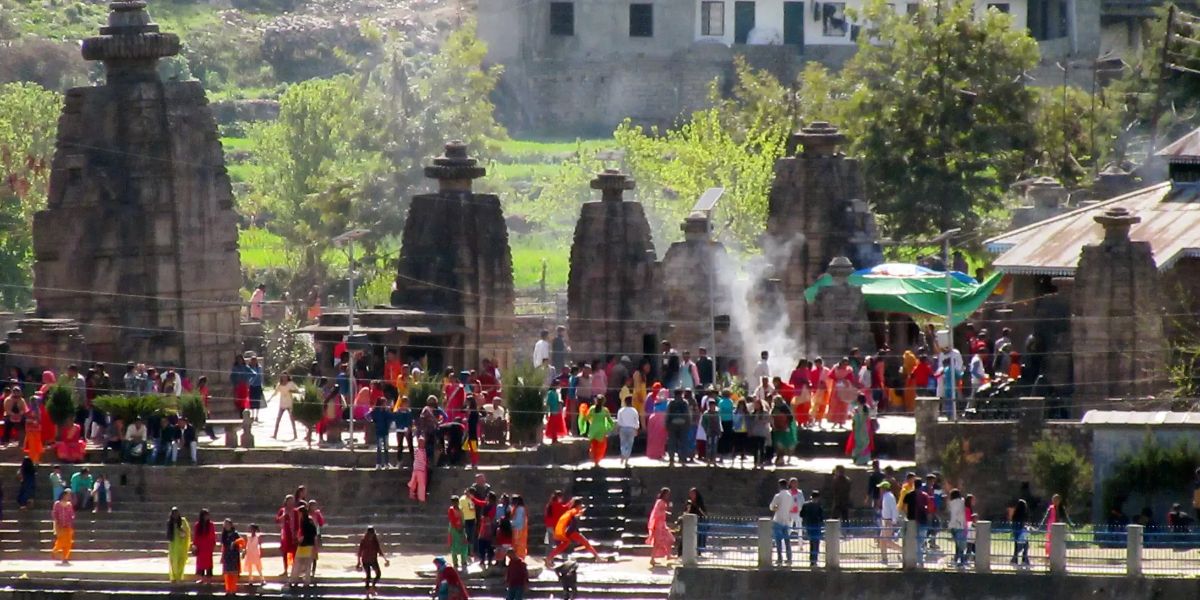There are temples that impress with sheer size, others with architectural grandeur, and then there are those that move you with their quiet strength. Bagnath Temple in Bageshwar, Uttarakhand, belongs to the last category. Perched at the sacred confluence of the Saryu and Gomti rivers, this ancient Shiva shrine has been a place of devotion, stories, and spiritual energy for centuries. For travelers seeking authenticity rather than spectacle, Bagnath Temple offers an unforgettable experience.
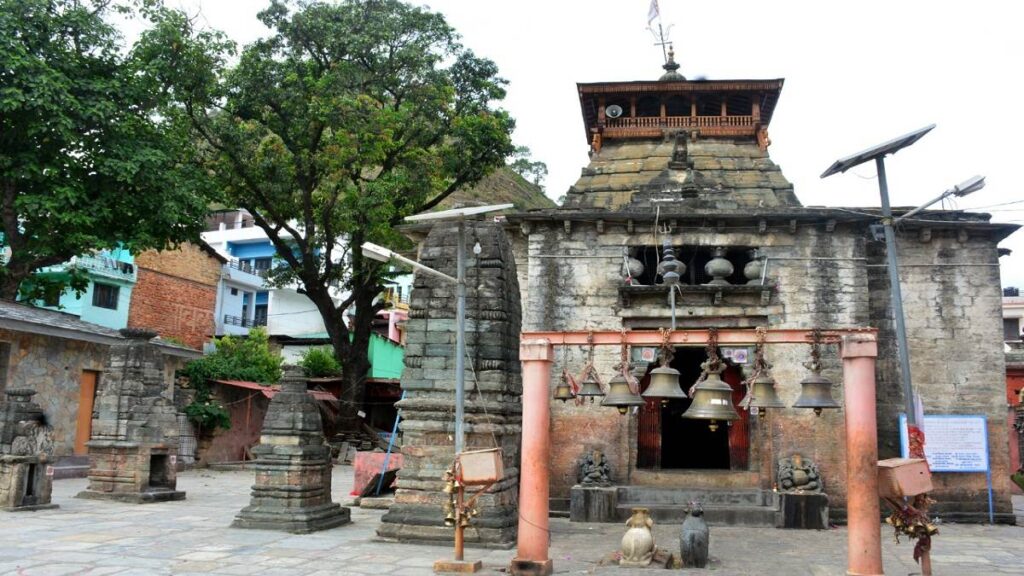
First Impressions – Where Rivers Meet
When you approach the town of Bageshwar, the first thing that strikes you is how the settlement itself seems to have grown around faith. The town takes its very name from the temple. Bageshwar translates to “Lord of the Tiger”, one of the many forms of Lord Shiva.
The temple stands at a sacred junction. On one side, the Gomti flows gently, while the Saryu rushes with more force, carrying with it the energy of the mountains. Standing on the temple’s stone steps, you can hear the water singing constantly, almost as if nature itself is in prayer.
Arriving here in the morning is an experience in itself. The mist hangs low on the riverbanks, bells begin to chime, and priests prepare the courtyard for the day’s rituals. There is no grandeur of high walls or golden spires, but there is an atmosphere that feels undeniably powerful.
The Architecture – Carved in Stone
The Bagnath Temple was built around the 15th century by the Chand rulers, though legends suggest its origins go back much earlier, possibly to the times when sage Markandeya performed penance here. The structure you see today reflects the classic Nagara style of temple architecture, which is common in North India.
The temple stands on a raised platform, with stone steps leading up to the sanctum. The walls are adorned with intricate carvings of deities, floral motifs, and mythological stories. These carvings, though weathered with time, still speak of the craftsmanship of the artisans who created them.
Inside the sanctum lies the Shiva lingam, constantly decorated with flowers, bilva leaves, and offerings from devotees. Unlike in larger, more commercialized temples, here the rituals feel intimate and personal. You can sit quietly, listen to the chanting, and watch as locals offer milk, honey, or water to the lingam with complete devotion.
Surrounding the main temple are numerous smaller shrines, dedicated to deities like Parvati, Ganesha, and other forms of Shiva. Together, the temple complex feels like a spiritual microcosm.

Legends and Stories
Every ancient temple carries stories, and Bagnath is no different. Locals say that sage Markandeya, known for his devotion to Shiva, meditated here. Pleased by his penance, Lord Shiva appeared before him in the form of Bageshwar, the lord of tigers, and blessed him.
Another tale suggests that this is the spot where the great sage performed rituals to invoke the river goddess, making this confluence sacred. The presence of flowing rivers adds weight to these legends, as water has always been a central element in Hindu spirituality.
During conversations with villagers, I heard how the temple is believed to protect the entire valley. People often say that worshiping here brings not just blessings but also courage, as the tiger form of Shiva symbolizes fearlessness and protection.
Daily Life Around the Temple
What makes Bagnath Temple so fascinating is not just its historical or mythological importance but also how it remains woven into daily life.
Every morning, you’ll find locals beginning their day with a dip in the river near the temple steps. Men and women bathe in the cold water even in winter, believing it purifies the body and spirit. Afterward, they light small lamps or offer flowers at the shrine before heading to their fields or shops.
The temple courtyard is also a gathering place. Pilgrims sit under the shade of trees, families spread out small mats for prasad, and wandering sadhus meditate silently. On festival days, the quiet transforms into vibrancy, with drums, chants, and long lines of devotees waiting to enter.
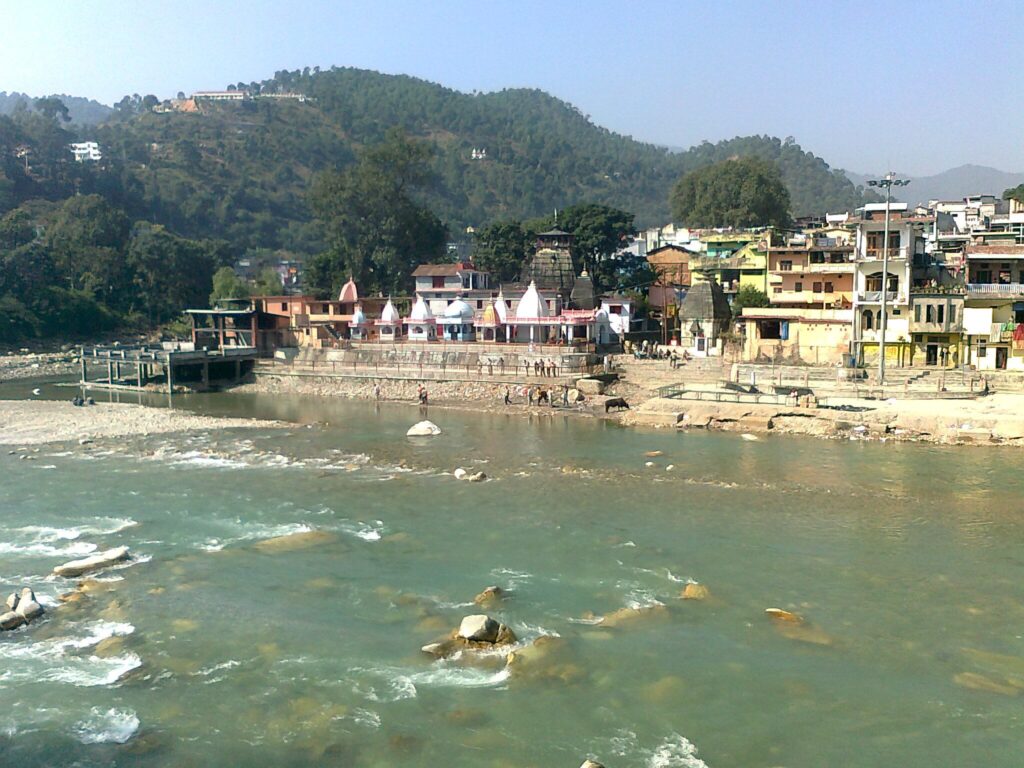
Festivals and Fairs – When the Temple Comes Alive
The most important festival at Bagnath Temple is Makar Sankranti, celebrated every January. It marks not only a religious occasion but also the famous Uttarayani fair.
For centuries, people from across Kumaon have traveled to Bageshwar for this fair. Farmers, artisans, and traders gather here, making it as much a cultural event as a spiritual one. Pilgrims take holy dips at the confluence, offer prayers at the temple, and then immerse themselves in the vibrant fair.
During this time, the entire town transforms. Stalls selling local produce, woolen clothes, and handcrafted goods line the streets. Folk songs and dances take over open spaces. The temple bells ring continuously, mingling with the laughter of children and the calls of vendors.
For a traveler, visiting during Makar Sankranti offers a window into how faith and culture are inseparable in Uttarakhand.
The Spiritual Experience
It’s hard to describe in words, but the energy of Bagnath Temple is undeniable. The sound of rivers, the smell of incense, the echo of chants, and the sight of devotees bowing in reverence create an atmosphere that lingers long after you leave.
Unlike grand temples where rituals feel rushed or distant, here the pace is slower. You can sit quietly for as long as you want, lost in thought or simply absorbing the surroundings. Many visitors say they feel lighter after offering prayers here, as if the temple helps carry away their worries.
For those on a spiritual journey, Bagnath serves as both a destination and a reminder of Shiva’s presence in everyday life.
Nearby Attractions
When you finish your prayers at the Bagnath Temple and step out onto the stone steps overlooking the river, the journey doesn’t have to end there. Bageshwar, though often overlooked in favor of bigger Himalayan destinations, is a treasure chest of experiences waiting to be unlocked. From peaceful riverbanks to high Himalayan trails, from old shrines to bustling local markets, the area around Bagnath Temple invites you to linger a little longer.
Here’s a look at some of the nearby attractions and experiences that will make your trip truly memorable.
1. The Confluence Ghats – Watching Life Flow By
Right outside the temple, where the Saryu and Gomti rivers merge, you’ll find stone ghats that are more than just a bathing spot. Sit here early in the morning, and you’ll see locals taking their ritual dip, women lighting oil lamps, and children playing by the water.
As the day progresses, the ghats transform into a hub of activity—priests performing rituals, traders stopping by before work, and pilgrims simply soaking in the view. In the evening, an aarti takes place with flickering lamps reflecting in the river, turning the whole atmosphere magical.
This isn’t just sightseeing—it’s immersing yourself in the rhythm of daily life in Bageshwar.
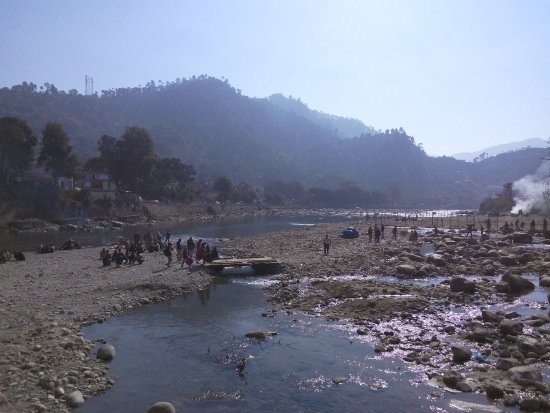
2. Chandika Devi Temple – Power of the Goddess
A short climb from Bageshwar town takes you to the Chandika Devi Temple, dedicated to Goddess Chandika, a fierce form of Durga. The temple isn’t just about worship; it’s about the panoramic view you get once you reach the top.
From here, the entire valley opens up—the rivers glistening like silver ribbons, the green hills rolling endlessly, and the town below buzzing quietly. Many locals will tell you that during Navratri, the temple becomes especially vibrant, with devotees walking barefoot up the hill to offer prayers.
If you enjoy combining spirituality with breathtaking views, this spot is a must.
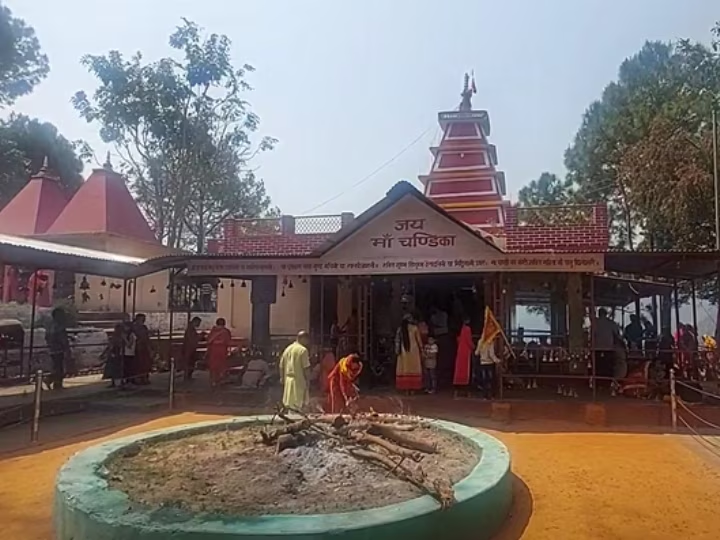
3. Baijnath Temple Complex – Stone Stories by the Gomti
About 16 kilometers from Bageshwar, the Baijnath Temple Complex is another gem of Kumaoni heritage. Dating back to the 9th century, these temples are dedicated to Lord Shiva in his form as Baijnath (the Lord of Physicians).
The highlight here is the stone carvings—intricate depictions of gods, goddesses, and celestial beings that have withstood centuries of weather. Standing by the Gomti river, the complex feels almost frozen in time.
And here’s something you don’t want to miss: the pond near the temple, filled with large, lazy fish. Locals believe feeding them brings good fortune, and watching them swim gracefully adds to the temple’s serenity.
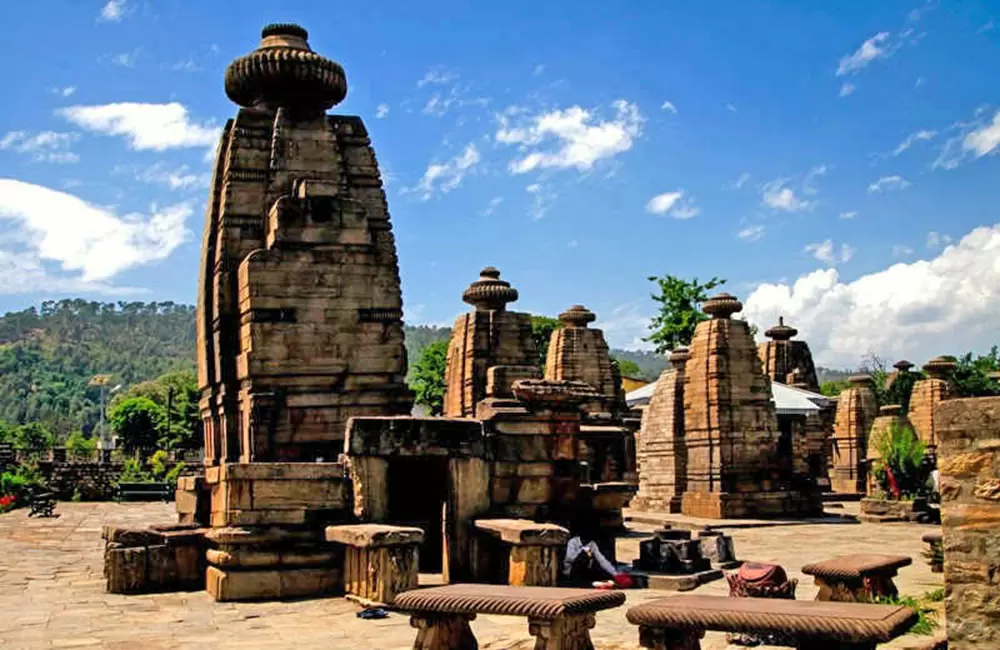
4. Kanda Village – A Window into Rural Life
If you want to move beyond temples, drive about 25 kilometers to Kanda, a charming little village surrounded by terraced fields and dense forests. Here, life is simple, and hospitality is warm.
Walk through the narrow lanes, and you’ll see mud-and-stone houses with slate roofs, children playing in the fields, and villagers going about their daily chores. The beauty of Kanda lies in its authenticity—it’s not a “resort town” but a lived-in community.
For trekkers, the forests around Kanda also offer short hiking routes where you can spot birds, small streams, and perhaps even a shy deer.
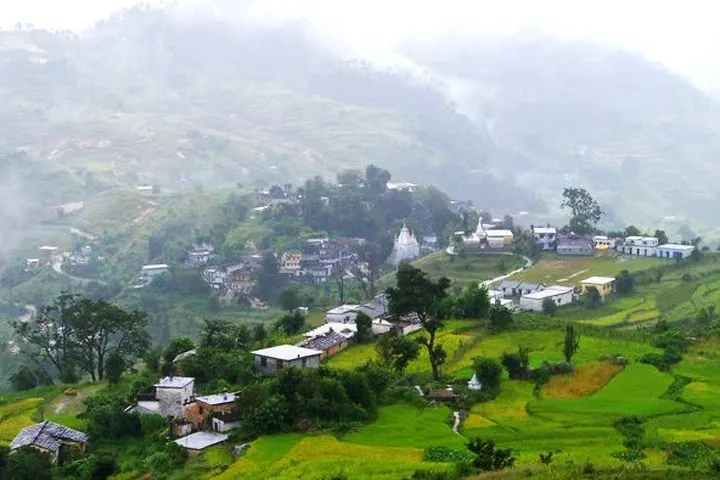
5. Pindari Glacier Trek – Adventure at Your Doorstep
For those with a love of trekking, Bageshwar is the starting point for the famous Pindari Glacier Trek. Often called the “trekker’s paradise,” this trail offers everything you’d want from a Himalayan adventure—thundering rivers, suspension bridges, remote villages, and ultimately, the grand sight of the Pindari Glacier.
The trek typically takes 5–6 days, so it’s not just a casual walk. But even if you’re not up for the full journey, shorter hikes on the initial stretches still provide unforgettable views. Imagine starting your trip with blessings at Bagnath Temple and then walking into the lap of the Himalayas. That’s Bageshwar for you—faith and adventure hand in hand.
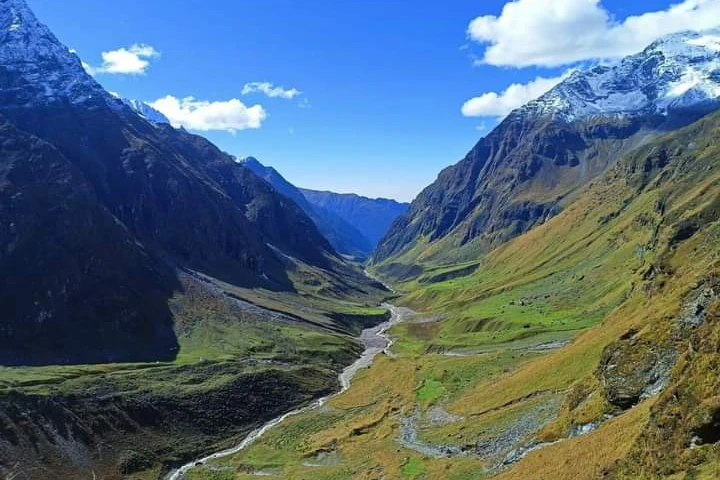
6. Gauri Udiyar – A Cave of Legends
About 8 kilometers from Bageshwar, you’ll find Gauri Udiyar, a natural cave shrine dedicated to Lord Shiva. Inside the cave are several carved idols, and the atmosphere is quiet and mysterious.
Locals say that saints used to meditate here for years, drawn by the cave’s seclusion and natural energy. If you enjoy exploring places that feel offbeat and slightly hidden, Gauri Udiyar will not disappoint. The walk to the cave, through fields and forest patches, adds to the charm.
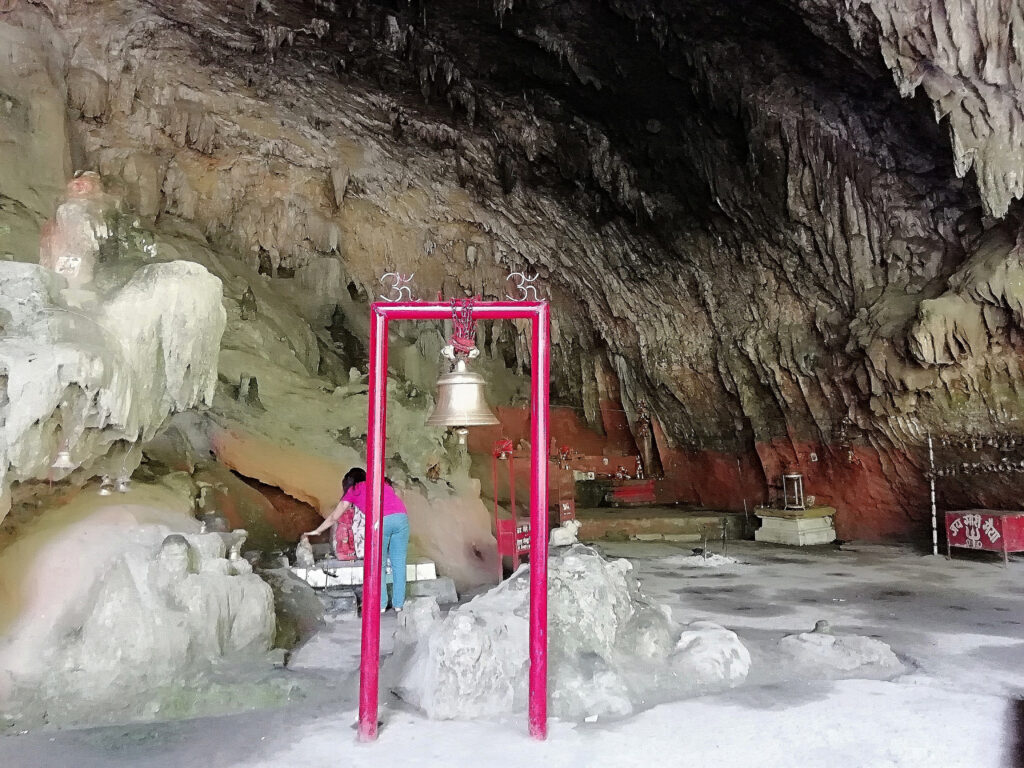
7. The Local Markets of Bageshwar – Culture in Every Corner
After temple-hopping and treks, don’t forget to stroll through Bageshwar’s local markets. These bazaars may look small compared to city ones, but they are full of character.
Here you can buy handwoven woolens, traditional copperware, organic grains, and local spices. During the Uttarayani fair in January, the market explodes with colors—stall after stall of handmade goods, sweets, and folk performances. Even outside festival time, just sitting with a cup of chai in a small shop and watching people pass by is an experience in itself.
8. Scenic Walks and Riverside Picnics
Not every attraction has to be about history or architecture. Sometimes the best way to enjoy Bageshwar is simply to wander. Take a slow walk along the riverside, find a quiet corner, and let the sound of rushing water be your background music.
Pack some local snacks—like singori (a sweet made of khoya wrapped in a leaf)—and you have the perfect riverside picnic. In the late afternoon, when the sun softens, the views become even more magical.
9. Exploring Towards Kausani – Valley of Sunsets
If you have extra time, drive about 40 kilometers to Kausani, often called the “Switzerland of India.” From here, the Himalayan peaks reveal themselves in their full glory—Trishul, Nanda Devi, and Panchachuli stand tall against the sky.
Kausani is famous for its sunsets, and many travelers combine a day trip to Bageshwar with a night in Kausani. Imagine visiting the ancient Bagnath Temple in the morning, and by evening, watching the sun dip behind snow-capped peaks. That’s a memory worth carrying.
10. The Spirit of Bageshwar – More than Places
At the end of the day, what makes Bageshwar truly special is not just its temples or trekking routes, but its spirit. It’s the old priest who patiently explains legends to curious visitors. It’s the child who runs along the ghats to offer flowers to the river. It’s the rhythm of bells, drums, and flowing water that lingers in your mind.
When you explore attractions around Bagnath Temple, you’re not just checking off places on a list—you’re experiencing a lifestyle where spirituality, nature, and community are deeply intertwined.
Exploring Bageshwar Beyond the Temple
While the temple is the main attraction, the town of Bageshwar has its own charm. Narrow lanes lead to small markets where you can buy local woolens, copper utensils, and organic produce. The riverside ghats are perfect for leisurely walks, especially at sunset when the sky turns golden and the temple lamps begin to glow.
For nature lovers, Bageshwar is also a gateway to trekking routes leading into the higher Himalayas, including paths towards Pindari and Sunderdhunga glaciers. This makes the town an interesting stop for both pilgrims and adventure seekers.
Practical Tips for Visitors
If you’re planning to visit Bagnath Temple, here are a few things to keep in mind:
- Best time to visit: The temple is open year-round, but the months of October to March offer pleasant weather. If you want to experience the Uttarayani fair, plan for January.
- Clothing: Dress modestly as it is an active place of worship. Winters can be very cold, so carry woolens.
- Offerings: Flowers, bilva leaves, milk, and sweets are common offerings. You can buy these from small shops near the temple.
- Respect the space: Photography is best done outside. Inside the sanctum, focus on the experience rather than the camera.
Why Bagnath Matters
In a world where temples often become tourist attractions stripped of their original soul, Bagnath Temple remains refreshingly authentic. It is not about grandeur or spectacle. Instead, it’s about continuity—the same rituals, chants, and offerings repeated for centuries, connecting generations of devotees.
For travelers, it’s a reminder that spirituality in India is not confined to monumental sites. It thrives in small towns, at river confluences, in simple stone shrines that hold the faith of entire communities.
Visiting Bagnath Temple isn’t just a sightseeing stop; it’s an encounter with living tradition.
FAQs
Q1. Where is Bagnath Temple located?
The temple is situated in Bageshwar town, Uttarakhand, at the confluence of the Saryu and Gomti rivers.
Q2. Who built the Bagnath Temple?
It was built in 1450 AD by King Laxmi Chand of the Chand dynasty.
Q3. Which deity is worshipped at the temple?
The temple is dedicated to Lord Shiva, worshipped as Bagnath (Lord of the Tiger).
Q4. Why is the temple significant?
It is believed that Sage Markandeya meditated here, and Lord Shiva appeared in the form of a tiger.
Q5. What is the architecture of Bagnath Temple like?
It features Nagara-style architecture with intricate stone carvings.
Q6. What festivals are celebrated at the temple?
Makar Sankranti is the biggest festival here, attracting thousands of devotees.
Q7. What are the temple timings?
The temple is generally open from early morning till evening for darshan.
Q8. Is there any entry fee for visitors?
No, entry to the temple is free.
Q9. How can one reach Bagnath Temple?
It is well connected by road; the nearest railway station is Kathgodam, about 180 km away.
Q10. What is the best time to visit Bagnath Temple?
October to March is ideal, though Makar Sankranti in January is the most auspicious time.

